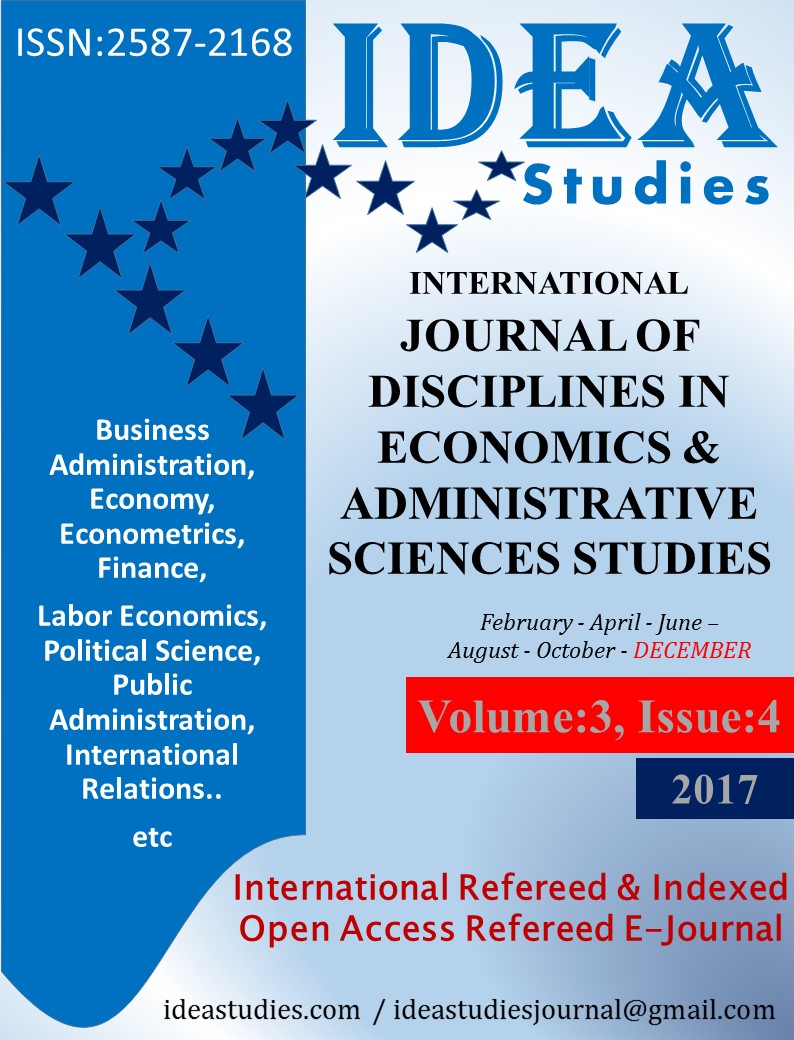Author :
Abstract
Ulusal Varlık Fonları, ülke hükümetleri tarafından kurulan ve kamu yararını gözeterek faaliyette bulunmayı amaçlayan yatırım kurumlarıdır. Dış ticaret fazlaları, özelleştirme gelirleri, doğal kaynak ve emtia satışları sonucunda elde edilen gelir fazlalıkları söz konusu fonların kaynağını oluşturmaktadır. Ulusal Varlık Fonları, sahip oldukları geniş sermaye yapıları ve geliştirdikleri yatırım stratejileri ile özellikle konjonktürel dalgalanmaların yaşandığı dönemlerde ekonominin daralmasını önleyici stabilizatör görevi üstlenmektedirler.
Ülkelerdeki iktisadi faaliyetlere yön veren temel faktörün kurumsal yapı olduğunu öne süren kurumsal iktisadi düşünce son yıllarda geniş bir yelpazede çalışma alanı bulmuştur. Bu çalışmada kurumsal iktisadi düşünceden hareketle, son yıllarda sayıları giderek artan varlık fonlarının kurumsal belirleyicileri Ulusal Varlık Fonuna sahip 5 ülke (Avustralya, Güney Kore, Singapur, Şili ve Yeni Zelanda) örneklemi için araştırılmıştır. 2006-2015 dönemini kapsayan çalışmada dinamik panel veri analiz tekniği kullanılmıştır. Kurumsal yapının göstergesi olarak iki farklı değişkenin kullanıldığı çalışmada elde edilen bulgular, kurumsal yapı ve ülkelerin varlık fonu büyüklüğü arasında anlamlı bir ilişki olduğunu ortaya koymaktadır. Bu kapsamda ülkelerdeki düzenleyici kalite ve demokratik sorumluluk göstergesindeki bir iyileşme varlık fonu miktarını olumlu etkilemektedir.
Keywords
Abstract
Sovereign Wealth Funds are investment institutions established by the governments of the country and aiming to operate in the public interest. Foreign trade surplus, privatization revenues, income surpluses resulting from natural resource and commodity sales constitute the source of such funds. Sovereign Wealth Funds act as stabilizers to prevent the economy from shrinking, especially in periods of cyclical fluctuations, due to the large capital structures they have and the investment strategies they have developed.
Institutional economic thought, which suggests that the main factor driving the economic activities in the countries is the institutional structure, has found a wide field of work in the last years. In this study, institutional determinants of increasing sovereign wealth funds, which have moved in recent years to institutional economic considerations, have been searched for 5 countries with Sovereign Wealth Fund (Australia, South Korea, Singapore, Chile and New Zealand). In the study dynamic panel data analysis technique was used covering the period of 2006-2015. In the study where two different variables were used as indicators of institutional structure support that there is a meaningful relationship between institutional structure and the size of sovereign wealth funds of countries. In this context, an improvement in regulatory quality and democratic accountability in countries affects the amount of wealth funds positively.
Keywords
- Al-Hassan, A.; Papaioannou, M. M. G.; Skancke, M. & Sung, C. C. (2013). Sovereign Wealth
- Al-Hassan, A.; Papaioannou, M. M. G.; Skancke, M. & Sung, C. C. (2013). Sovereign WealthFunds: Aspects of Governance Structures and Investment Management. International Monetary Fund, No. 13-231.
- Allen, M. & Caruana, J. (2008). Sovereign Wealth Funds: A Work Agenda. International Monetary Fund, No. 29.
- Arellano, M. & Bond, S. (1991). Some Tests Specification for Panel Data: Monte Carlo Evidenceand an Application to Employment Equations. The Review of Economic Studies. 58(2): 277-297.
- Bahgat, G. (2008). Sovereign Wealth Funds: Dangers and Opportunities. International Affairs, 84(6): 1189-1204.
- Bernstein, S.; Lerner, J. & Schoar, A. (2013). The Investment Strategies of Sovereign Wealth Funds. The Journal of Economic Perspectives, 27(2): 219-238.
- Betbèze, J. P. (2009). Sovereign Wealth Funds: a Solution to the Crisis?. Revue d'Économie Financière, Special Issue, 9(1): 157-162.
- Blundell-Wignall, A.; Hu, Y. W. & Yermo, J. (2008). Sovereign Wealth and Pension Fund Issues. OECD Working Papers on Insurance and Private Pensions, No. 14.
- Capapé, Javier & Blanco, Tomás Guerrero (2014). More Layers than an Onion: Looking For a Definition of Sovereign Wealth Funds. ESADEgeo Working Paper, 21: 1-38.
- Castelli, M. & Scacciavillani, F. (2012). The New Economics of Sovereign Wealth Funds. WILEY, A John Wiley and Sons, Ltd, Publication
- Clark, S.; Hope, B. & Lamar, M. (2015). The Trouble With Sovereign-Wealth Funds: GovernmentFunds Proliferated with Oil's Rise. Now Some are Troubled. Wall Street Journal Online,https://www.wsj.com/articles/the-trouble-with-sovereign-wealth-funds-1450836278 (Erişim Tarihi: 29.06.2017)
- Das, D. K. (2009). Sovereign-wealth Funds: The Institutional Dimension. International Review of Economics, 56(1): 85-104.
- Das, U. S.; Lu, Y.; Mulder, C. B. & Sy, A. N. (2009). Setting up a Sovereign Wealth Fund: Some Policy and Operational Considerations. International Monetary Fund, No. 9-179.
- Drezner, D. W. (2008). Sovereign Wealth Funds and the (in) Security of Global Finance. Journal of International Affairs, 62(1): 115-130.
- Gasparro, Vincent & Pagano, Michael S. (2010). Sovereign Wealth Funds' Impact on Debt and Equity Markets during the 2007-09 Financial Crisis. Financial Analysts Journal, 66(3): 92-103.
- Jory, S. R.; Perry, M. J. & Hemphill, T. A. (2010). The Role of Sovereign Wealth Funds in Global Financial Intermediatio. Thunderbird International Business Review, 52(6): 589-604.
- Keller, A. D. (2008). Sovereign Wealth Funds: Trustworthy Investors or Vehicles of StrategicAmbition? An Assessment of the Benefits, Risks and Possible Regulation of Sovereign Wealth Funds. Georgetown Journal of Law&Public Policy, 7(1): 332-372.
- Kimmitt, R. M. (2008). Public Footprints in Private Markets: Sovereign Wealth Funds and the World Economy. Foreign Affairs, 119-130.
- Makhlouf, H. H. (2010). Sovereign Wealth Funds. International Journal of Government Financial Management, 10(1): 35.
- Murtinu, S. & Scalera, V. G. (2016). Sovereign Wealth Funds' Internationalization Strategies: The Use of Investment Vehicles. Journal of International Management, 22(3): 249-264.
- PRS (2016), ICRG Data Base.
- Schwartz, H. (2012). Political Capitalism and the Rise of Sovereign Wealth Funds. Globalizations, 9(4): 517-530.
- Shabbir, Tayyeb (2009). Role of the Middle Eastern Sovereign Wealth Funds in the Current Global Financial Crisis. Topics in Middle Eastern and African Economies, 11: 1-19.
- SWF Institute, https://www.swfinstitute.org/sovereign-wealth-fund-rankings/ Erişim Tarihi: 01.11.2017
- Tatoğlu, F.Y., (2013). İleri Panel Veri Analizi: Stata Uygulamalı, Beta Basım, 2. Baskı, İstanbul.
- Weiss, M. A. (2008). Sovereign Wealth Funds: Background and Policy Issues for Congress. Congressional Research Service, Library of Congress.
- World Bank (2017). World Development Indicators Data Base.
- World Bank (2017). Worldwide Governance Indicators Data Base.





